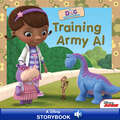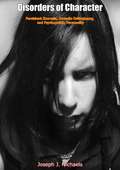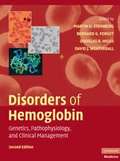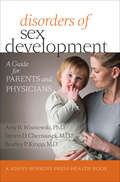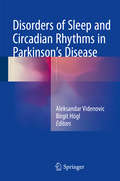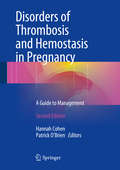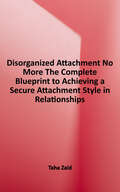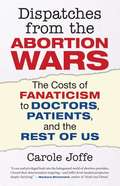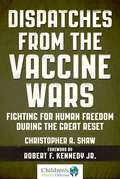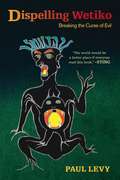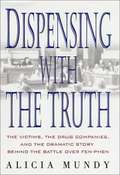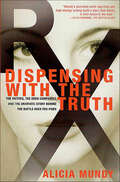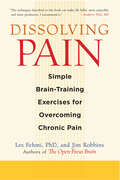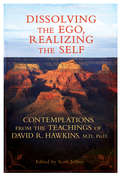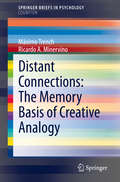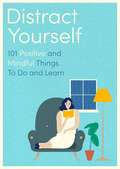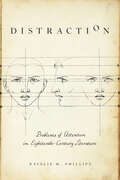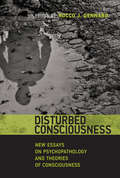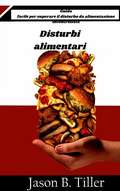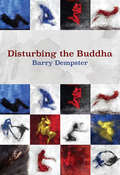- Table View
- List View
Disney Junior: Doc McStuffins: Training Army Al
by Disney PressRead along with Disney! Donny is heading out on his Badger Scout camping trip, and Doc knows only the bravest and strongest toy can accompany him. Army Al volunteers for the job so that all of his friends can stay home and be safe. Follow along with word-for-word narration to see if Doc and the toys can help Army Al train for every rough, tough, and sticky situation. This soldier is ready for duty, and his friends can't wait for him to come home safe and sound!
Disorders of Character: Persistent Enuresis, Juvenile Delinquency, and Psychopathic Personality
by Joseph J. Michaels“ON NUMEROUS occasions I have been requested to write a review of my articles on persistent enuresis, juvenile delinquency, and psychopathic personality which were published over a period of 18 years. In response I have attempted here to synthesize the individual reports into an integrated whole. All of the work stemmed originally from a clinical interest spurred on by a clinical hunch that there was an intimate association between persistent enuresis and personality mal-integration. This same interest led finally, in the later papers, to the consideration of character problems. The conceptions elaborated here are simple. I believe that they have general validity and that their fundamental nature can lead to significant bio-psycho-social implications.”—Dr. Joseph J. MichaelsDr. Joseph J. Michaels has divided his 12 papers, published over an 18-year period, into four series:The first series (four papers) deals with studies of so-called normal children (controls) and neuropsychiatric patients, presenting data and their analysis primarily from a statistical standpoint.The second series (four papers) consists in the analysis and interpretation of data pertaining to enuresis in the reports of other authors on delinquent and psychotic individuals.The third series (two papers) is concerned with the relationship of enuresis, and of neurotic and anti-social traits to the electroencephalogram in children with behavior disorders.The fourth series (two papers) is much broader in scope: the previous data, hypotheses and conclusions are re-evaluated against a background of the total personality viewed psychobiologically and psychoanalytically.
Disorders of Hemoglobin: Genetics, Pathophysiology, and Clinical Management
by Martin H. Steinberg Bernard G. Forget Douglas R. Higgs David J. WeatherallThis book is a completely revised new edition of the definitive reference on disorders of hemoglobin. Authored by world-renowned experts, the book focuses on basic science aspects and clinical features of hemoglobinopathies, covering diagnosis, treatment, and future applications of current research. While the second edition continues to address the important molecular, cellular, and genetic components, coverage of clinical issues has been significantly expanded, and there is more practical emphasis on diagnosis and management throughout. The book opens with a review of the scientific underpinnings. Pathophysiology of common hemoglobin disorders is discussed next in an entirely new section devoted to vascular biology, the erythrocyte membrane, nitric oxide biology, and hemolysis. Four sections deal with α and β thalassemia, sickle cell disease, and related conditions, followed by special topics. The second edition concludes with current and developing approaches to treatment, incorporating new agents for iron chelation, methods to induce fetal hemoglobin production, novel treatment approaches, stem cell transplantation, and progress in gene therapy.
Disorders of Sex Development: A Guide for Parents and Physicians (A Johns Hopkins Press Health Book)
by Amy B. Wisniewski Steven D. Chernausek Bradley P. KroppCompassionately written by an experienced team of professionals, this book offers parents and families essential information about the causes, diagnosis, and treatment of disorders of sex development, or DSD.DSD refers to medical conditions, usually discovered at birth, in which there is disagreement between a person's genetic sex (i.e., chromosomes) and the appearance of the person's external or internal reproductive structures. After their child is diagnosed with DSD, parents need answers to a host of questions, including• What is DSD, why does it occur, how is it identified, and how is it treated?• Did we do something to cause our child's DSD?• Is my baby a boy or a girl?• Will my child grow up to be normal and healthy?• Does my child need surgery?This concise book answers parents' questions in a reassuring and forthright way, giving affected individuals, their families, and their health care providers a current and evidence-based picture of DSD. It offers clear explanations of how newborns with DSD are evaluated, diagnosed, and treated; describes the different kinds of DSD; and pays close attention to both psychosocial and medical aspects of DSD. This guide also includes information about the importance of support groups and education for affected individuals and their families.In their daily work, the authors treat, support, and educate people with DSD and their families. This resource gives parents and families access to the authors' expertise so they can reach a meaningful understanding of their child's DSD and make informed decisions about their child's health.
Disorders of Sleep and Circadian Rhythms in Parkinson's Disease
by Aleksandar Videnovic Birgit HöglThis book is the first to take into account the rapidly growing body of knowledge on the relation between sleep and PD. Gathering contributions from internationally recognized experts, it provides a unique source of in-depth information on sleep and circadian dysregulation in Parkinson's disease. The book is divided into two parts: the first comprises chapters on normal sleep-wake homeostasis, followed by changes that occur in PD and discussions of available tools for the assessment of sleep-wake cycles in PD. In the second part, sleep and circadian disorders associated with PD are described in individual chapters, including sections on epidemiology, etiology, pathogenesis, differential diagnosis, and treatment. Controversies in the field, such as the relations between cognition and sleep, fatigue and sleepiness, and the potential impact of surgical therapies on sleep-wake cycles are discussed separately. The book closes with a chapter on future directions and unmet needs in the field of sleep, circadian biology and PD. This comprehensive text offers a readily accessible resource for clinicians and researchers alike, addressing the needs of neurologists, sleep and movement disorders specialists, and all trainees and allied health professionals involved in the care of patients affected by Parkinson's disease.
Disorders of Thrombosis and Hemostasis in Pregnancy
by Hannah Cohen Patrick O'BrienThis book will offer a comprehensive guide to disorders of thrombosis and haemostasis in pregnancy. It will highlight the latest developments and controversial issues. The multidisciplinary approach will provide authoritative clinical advice on state-of-the-art management. The disorders to be covered are highly pertinent to successful pregnancy outcome, and many may be associated with significant maternal and/or fetal morbidity, and even mortality. This book will be relevant for individuals in all disciplines involved in the care of women with disorders of thrombosis and haemostasis in pregnancy.
Disorganized Attachment No More!: The Complete Blueprint to Achieving a Secure Attachment Style in Relationships
by Taha ZaidIt's time to control those overflowing emotions, understand your patterns, and identify the way forward toward a healthier, happier relationship. Have you been dealing with a rollercoaster of emotions that seem to create roadblocks to your happiness? Do you sometimes feel it would be easier if you stayed single because you didn't want to put someone through your spinning thoughts? Do you self-sabotage when it comes to deciding what you need to do and your happiness? Listen, the most common culprit for blocking our own happiness is us. The negativity that you have accumulated over your life, from childhood till now, has been clouding your decision-making and causing you to see life in gray. You see, past experiences have a way of seeping into our present and future. They have the power to create an environment where you overthink and overanalyze every little detail–what a person said, how you responded, their body language, your own body language…the list goes on and on! That is what stops you from having your happily ever after. You are probably dealing with disorganized attachment, but you aren’t really sure what that means. Science has categorized it as a disorder, and luckily, it's a condition that is treatable. This is your chance to go from disorganized attachment to healthy relationships and from chaotic emotions to a more focused outlook on life. It's time to truly tap into the details of your past to create a happier future. In this practical guide, you will discover: - The nooks and crannies of insecure attachments that can help you understand disorganized attachment even more - The image of a healthy relationship – uncover exactly what it takes to build that secure connection with that special someone - Techniques to pinpoint the signs of disorganized attachment in yourself and others that will open your eyes to a new world of emotions - Methods of emotional control to truly face your fears, understand your past childhood trauma, and pinpoint your triggers - How to save your relationship by focusing on yourself and using the power of communication - The art of improvement, from how to improve your self-worth to your confidence so you can go through your adult life more organized - How to move forward in life with various techniques like self-healing and building yourself up And much more. When it comes to keeping your relationships safe, taking the step to improving your own skills and confidence might be the key you have been looking for. With this guide, you can understand where your feelings are from and how to deal with them.
Dispatches from the Abortion Wars: The Costs of Fanaticism to Doctors, Patients, and the Rest of Us
by Carole JoffeJoffe (sociology, U. of California Davis and U. of California San Francisco) illustrates the costs of the "abortion wars" for those seeking abortions and those providing them, as well as American society in general, due to the violent actions and extremist politics of the fanatical sector of the anti-abortion movement. Drawing in part from interviews with providers over the past 30 years, she addresses the causes of this fanaticism, the stigma of abortion in medical culture, issues involved in training doctors, regulation, problems faced by low-income women, aspects of effective abortion care, and stories from patients and those at clinics. Annotation ©2010 Book News, Inc., Portland, OR (booknews.com)
Dispatches from the Vaccine Wars: Fighting for Human Freedom During the Great Reset (Children’s Health Defense)
by Christopher A. ShawEnter the trenches of the bloodiest battles you've never heard of: the Vaccine Wars. Professor Christopher A Shaw discovered, after a deep-dive literature search on aluminum impacts on humans and animals, that aluminum hydroxide, an adjuvant in the anthrax vaccine, had a significantly negative impact on motor functions and reflexes of patients in the literature. After that finding, he did what scientists are supposed to do and kept following the leads. However, organizations like WHO dismissed him immediately. Those powerful organizations either knew what he knew, that aluminum vaccine adjuvants were harmful, or they simply didn&’t care. In either case, two possible reasons for the lack of response became clear to Shaw and his colleagues: dogma and money. The first had served to convince most of the world&’s medical professionals that Shaw had to be wrong because, after all, &“the science was settled.&” And, behind much of this was the naked fact of how much money vaccines brought in to cover the pharmaceutical industry&’s profit margin. The combination of those two have the finger prints of various Big Pharma companies smudged all over the question of vaccine safety, which included the demonization of both scientists and lay scholars who raised even the tamest questions about safety and the push for vaccine mandates around the world. After these events, Shaw decided to dig deeper.Dispatches from the Vaccine Wars is a comprehensive look at the origin of vaccination and the oversight of vaccines by various regulatory bodies in the United States and in Canada. The book provides not only the official view on vaccines safety and efficacy, but also provides a critical analysis on which such views are based. Aluminum and other compounds that may contribute to autism spectrum disorder are discussed at length. Professor Shaw also analyzes the corporate influences driving vaccine uptake worldwide and provides an in depth look at the push for mandatory vaccination. Dispatches from the Vaccine Wars evaluates the extent to which vaccinology has become a cult religion driving attempts to suppress divergent scientific opinions. Finally, the book delves into the COVID-19 pandemic and what it means for the future of us all.
Dispelling Wetiko: Breaking the Curse of Evil
by Paul Levy Catherine Austin FittsThere is a contagious psychospiritual disease of the soul, a parasite of the mind, that is currently being acted out en masse on the world stage via a collective psychosis of titanic proportions. This mind-virus--which Native Americans have called "wetiko"--covertly operates through the unconscious blind spots in the human psyche, rendering people oblivious to their own madness and compelling them to act against their own best interests. Drawing on insights from Jungian psychology, shamanism, alchemy, spiritual wisdom traditions, and personal experience, author Paul Levy shows us that hidden within the venom of wetiko is its own antidote, which once recognized can help us wake up and bring sanity back to our society.From the Trade Paperback edition.he fact that so many people seem to be oblivious to the absolute insanity of it all.For those who are looking at the current state of affairs and wondering how such madness can proliferate, Levy provides an answer--as well as a solution. Lying dormant in the venom of wetiko, he says, is its antidote--one that can help us wake ourselves and each other up from this mass hypnosis and finally bring sanity back to society.From the Trade Paperback edition.
Dispencing with the Truth: The Victims, the Drug Companies, and the Dramatic Story Behind the Battle Over Fen-Phen
by Alicia MundyIn 1996, a terrible epidemic began killing young American women. Some died quickly, literally dropping in their steps. Others took more time, from a few months to a few years. Those who weren't killed suffered damage to their lungs and hearts, much of it permanent and reparable only with major surgery. Doctors suspected what the killer was. So did the Food and Drug Administration. The culprits were the two most popular diet drugs in the United States, Pondimin, one-half of the popular drug combination Fen-Phen, and Redux, a stronger version of Pondimin. They were also two of the most profitable drugs on the market, and both were produced and sold by a powerful pharmaceutical company, Wyeth-Ayerst, a division of American Home Products. Dispensing the Truth is the gripping story of who really knew about the drugs, the ways they kept this information from the public, doctors, and FDA, and the massive legal battles that ensued as victims and their attorneys searched for the truth behind the debacle. It tells the story of a healthy young woman, Mary Linnen, who took the drugs for only twenty-three days to lose weight before her wedding, and then died in the arms of her fiance a few months later. Hers was the first wrongful-death suit filed and would become the most important single suit the company would ever face. Alicia Mundy provides a shocking and thoroughly riveting narrative. It is a stark look at the consequences of greed and a cautionary tale for the future.
Dispensing with the Truth: The Victims, the Drug Companies, and the Dramatic Story Behind the Battle over Fen-Phen
by Alicia MundySemi-finalist for the Robert F. Kennedy Memorial Book AwardIn 1996, a terrible epidemic began killing young American women. Some died quickly, literally dropping in their steps. Others took more time, from a few months to a few years. Those who weren't killed suffered damage to their lungs and hearts, much of it permanent and reparable only with major surgery. Doctors suspected what the killer was. So did the Food and Drug Administration. The culprits were the two most popular diet drugs in the United States, Pondimin, one-half of the popular drug combination Fen-Phen, and Redux, a stronger version of Pondimin. They were also two of the most profitable drugs on the market, and both were produced and sold by a powerful pharmaceutical company, Wyeth-Ayerst, a division of American Home Products. Dispensing the Truth is the gripping storry of what the drug really knew about its drugs, the ways it kept this information from the public, doctors, and FDA, and the massive legal battles that ensued as victims and their attorneys searched for the truth behind the debacle.It tells the story of a healthy young woman, Mary Linnen, who took the drugs for only twenty-three days to lose weight before her wedding, and then died in the arms of her fiance a few months later. Hers was the first wrongful-death suit filed amd would become the most important single suit the company would ever face.Alicia Mundy provides a shocking and thoroughly riveting narrative. It is a stark look at the consequences of greed and a cautionary tale for the future.
Dissent in Medicine: Nine Doctors Speak Out
by The New Medical FoundationThese essays are about different dimensions of modern medicine such as how much science is there in modern medicine, treatment for some cancers, environmental issues in medicine, choking, drowning and resuscitation, corruption in American medicine, the accuracy of medical testing, effectiveness of treatment, immunizations and hospital births.
Dissolving Pain: Simple Brain-Training Exercises for Overcoming Chronic Pain
by Jim Robbins Les FehmiFor four decades, Dr. Les Fehmi has been training people to regulate their own brainwave patterns to improve their mental, emotional, and physical health. His new book focuses on the treatment of pain, and it is based on the premise that although pain is perceived to exist in a particular part of the body, pain actually arises in the brain.Drawing on existing scientific research and on decades of clinical experience, he offers brain-training exercises that quiet the pain signal in the brain. The exercises involve altering the way we pay attention to pain, cultivating what Fehmi calls Open-Focus Attention: a relaxed form of awareness that changes the neural blood flow and increases alpha brainwave activity (associated with reduced stress and beneficial hormonal changes). These exercises are effective in the treatment of many forms of pain including back, shoulder, neck, and joint pain; headaches; muscle pain and tension; and pain from traumatic injury.Included with the book is a 60-minute program that guides listeners through the Open-Focus exercises to help them to become pain free.
Dissolving the Ego, Realizing the Self
by David R. Hawkins Jeffrey ScottHow does one traverse the spiritual landscape to move beyond suffering to experience the peace and love of God, to dissolve illusion and realize the state of enlightenment? In this collection of inspiring passages from David R. Hawkins’s work, the reader is reminded of the illusory nature of the personal self (identification of the ego/mind) and the direct pathways to dissolve the ego/mind’s trappings. This pocket edition is designed especially for today’s spiritual student on the go, to inspire contemplation and reflection during a break at work, while hiking in the woods, during a quiet coffee-shop moment, on an airplane, with a partner—in whatever environment one finds oneself. Dissolving the Ego, Realizing the Self is a reliable companion on the aspirant’s quest toward higher truth.
Distant Connections: The Memory Basis of Creative Analogy (SpringerBriefs in Psychology)
by Máximo Trench Ricardo A. MinervinoAnalogical thinking lies at the core of human cognition, pervading from the most mundane to the most extraordinary forms of creativity. By connecting poorly understood phenomena to learned situations whose structure is well articulated, it allows reasoners to expand the boundaries of their knowledge. The first part of the book begins by fleshing out the debate around whether our cognitive system is well-suited for creative analogizing, and ends by reviewing a series of studies that were designed to decide between the experimental and the naturalistic accounts. The studies confirm the psychological reality of the surface bias revealed by most experimental studies, thus claiming for realistic solutions to the problem of inert knowledge. The second part of the book delves into cognitive interventions, while maintaining an emphasis on the interplay between psychological modeling and instructional applications. It begins by reviewing the first generation of instructional interventions aimed at improving the later retrievability of educational contents by highlighting their abstract structure. Subsequent chapters discuss the most realistic avenues for devising easily-executable and widely-applicable ways of enhancing access to stored knowledge that would otherwise remain inert. The authors review results from studies from both others and their own lab that speak of the promise of these approaches.
Distract Yourself: 101 positive and mindful things to do or learn
by Distract YourselfSUITABLE FOR KINDLE AND OTHER EBOOK DEVICESSwitch off the news and mute your tense WhatsApp chats - here are 101 family-friendly, fun, smart, silly, useful, good-to-know things to do and learn that will take your mind off what's going on outside the comfort of your own home, providing you with plenty of much needed moments of positivity and calm. Including (but not limited to!):· Quizzes· Anagrams· Poems· Riddles· Jokes· Word games· Fun facts· And other ways to occupy your time in a fulfilling way.Suitable for those aged 7 to 107, with the quizzes requiring some grown-up knowledge.And whilst you #StayHome, don't miss these other great titles from Sphere Books:** The Bumper Book of Would You Rather? Over 350 hilarious hypothetical questions for ages 6 to 106 **** Home Sweet Home: The Little Book of Natural Cleaning **** Shelf Respect: A Book Lovers' Guide to Curating Book Shelves at Home **
Distract Yourself: 101 positive and mindful things to do or learn
by SphereSUITABLE FOR KINDLE AND OTHER EBOOK DEVICESSwitch off the news and mute your tense WhatsApp chats - here are 101 family-friendly, fun, smart, silly, useful, good-to-know things to do and learn that will take your mind off what's going on outside the comfort of your own home, providing you with plenty of much needed moments of positivity and calm. Including (but not limited to!):· Quizzes· Anagrams· Poems· Riddles· Jokes· Word games· Fun facts· And other ways to occupy your time in a fulfilling way.Suitable for those aged 7 to 107, with the quizzes requiring some grown-up knowledge.And whilst you #StayHome, don't miss these other great titles from Sphere Books:** The Bumper Book of Would You Rather? Over 350 hilarious hypothetical questions for ages 6 to 106 **** Home Sweet Home: The Little Book of Natural Cleaning **** Shelf Respect: A Book Lovers' Guide to Curating Book Shelves at Home **
Distraction: Problems of Attention in Eighteenth-Century Literature
by Natalie M. PhillipsEnlightenment writers fiercely debated the nature of distraction in literature.Early novel reading typically conjures images of rapt readers in quiet rooms, but commentators at the time described reading as a fraught activity, one occurring amidst a distracting cacophony that included sloshing chamber pots and wailing street vendors. Auditory distractions were compounded by literary ones as falling paper costs led to an explosion of print material, forcing prose fiction to compete with a dizzying array of essays, poems, sermons, and histories. In Distraction, Natalie M. Phillips argues that prominent Enlightenment authors—from Jane Austen and William Godwin to Eliza Haywood and Samuel Johnson—were deeply engaged with debates about the wandering mind, even if they were not equally concerned about the problem of distractibility.Phillips explains that some novelists in the 1700s—viewing distraction as a dangerous wandering from singular attention that could lead to sin or even madness—attempted to reform diverted readers. Johnson and Haywood, for example, worried that contemporary readers would only focus long enough to "look into the first pages" of essays and novels; Austen offered wry commentary on the issue through the creation of the daft Lydia Bennet, a character with an attention span so short she could listen only "half-a-minute." Other authors radically redefined distraction as an excellent quality of mind, aligning the multiplicity of divided focus with the spontaneous creation of new thought. Laurence Sterne’s Tristram Shandy, for example, won audiences with its comically distracted narrator and uniquely digressive form.Using cognitive science as a framework to explore the intertwined history of mental states, philosophy, science, and literary forms, Phillips explains how arguments about the diverted mind made their way into the century’s most celebrated literature. She also draws a direct link between the disparate theories of focus articulated in eighteenth-century literature and modern experiments in neuroscience, revealing that contemporary questions surrounding short attention spans are grounded in long conversations over the nature and limits of focus.
Distrust, Fear, and Science-Denial in Medicine and Healthcare
by Anthony Wrigley Markus WolfensbergerOver recent decades, the decline of trust, mounting of fears, and increasing denial of science appear as a marked shift of societal attitudes towards many institutions and professionals. This book analyses these developments and looks at their role in medicine and healthcare, both in terms of the patient-physician relationship and for delivering high-quality healthcare, in order to establish why we need trust and what can be done to restore it. The book begins by offering a conceptual analysis and definition of trust, using a ‘pattern definition’ based upon typical features and common usage of the term, as well as the related concepts of hope, fear, and belief. It charts evidence for the decline of public trust in various professions, and then looks at the causes, as well as the accompanying growth of fear and the rejection of science. The study addresses possible options for restoring trust in medicine and healthcare, be it in individual physicians, in hospitals, or in managed care institutions. Written jointly by a medical doctor and an academic specialising in biomedical ethics, the book will be of interest to those working in the areas of biomedical ethics and law, medicine and healthcare, public health, philosophy, sociology, politics, and psychology.
Disturbances of the Mind
by Douwe Draaisma Barbara FastingSergei Korsakoff, Alois Alzheimer, James Parkinson, Hans Asperger and other eminent scientists, are all names which have become synonymous with a disease, a syndrome, or an autistic disorder. Although the names of these psychiatrists and neurologists are familiar, we often know little about the individuals themselves and the circumstances surrounding their discoveries. What exactly did they discover, and who were their patients? Douwe Draaisma expertly reconstructs the lives of these and eight other 'names' from the science of mind and brain. Disturbances of the Mind provides a fascinating, illuminating, and at times touching insight into the history of brain research. Thanks to Draaisma's unerring eye and elegant, engaging style, the case histories of Asperger, Bonnet, Capgras, Clérambault, Korsakoff and Gilles de la Tourette syndromes; Alzheimer's and Parkinson's diseases; the areas of Broca and Brodmann; Jackson's epilepsy; and the Gage matrix are all brought to life and transformed into unforgettable tales.
Disturbed Consciousness
by Rocco J. GennaroIn Disturbed Consciousness, philosophers and other scholars examine various psychopathologies in light of specific philosophical theories of consciousness. The contributing authors -- some of them discussing or defending their own theoretical work -- consider not only how a theory of consciousness can account for a specific psychopathological condition but also how the characteristics of a psychopathology might challenge such a theory. Thus one essay defends the higher-order thought (HOT) theory of consciousness against the charge that it cannot account for somatoparaphrenia (a delusion in which one denies ownership of a limb). Another essay argues that various attempts to explain away such anomalies within subjective theories of consciousness fail.Other essays consider such topics as the application of a model of unified consciousness to cases of brain bisection and dissociative identity disorder; prefrontal and parietal underconnectivity in autism and other psychopathologies; self-deception and the self-model theory of subjectivity; schizophrenia and the vehicle theory of consciousness; and a shift in emphasis away from an internal (or brainbound) approach to psychopathology to an interactive one. Each essay offers a distinctive perspective from the intersection of philosophy, consciousness research, and psychiatry.ContributorsAlexandre Billon, Andrew Brook, Paula Droege, Rocco J. Gennaro, Philip Gerrans, William Hirstein, Jakob Hohwy, Uriah Kriegel, Timothy Lane, Thomas Metzinger, Erik Myin, Inez Myin-Germeys, Myrto Mylopoulos, Gerard O'Brien, Jon Opie, J. Kevin O'Regan, Iuliia Pliushch, Robert Van Gulick
Disturbed Consciousness: New Essays on Psychopathology and Theories of Consciousness (Philosophical Psychopathology)
by Rocco J. GennaroEssays defend, discuss, and critique specific theories of consciousness with respect to various psychopathologies.In Disturbed Consciousness, philosophers and other scholars examine various psychopathologies in light of specific philosophical theories of consciousness. The contributing authors—some of them discussing or defending their own theoretical work—consider not only how a theory of consciousness can account for a specific psychopathological condition but also how the characteristics of a psychopathology might challenge such a theory. Thus one essay defends the higher-order thought (HOT) theory of consciousness against the charge that it cannot account for somatoparaphrenia (a delusion in which one denies ownership of a limb). Another essay argues that various attempts to explain away such anomalies within subjective theories of consciousness fail.Other essays consider such topics as the application of a model of unified consciousness to cases of brain bisection and dissociative identity disorder; prefrontal and parietal underconnectivity in autism and other psychopathologies; self-deception and the self-model theory of subjectivity; schizophrenia and the vehicle theory of consciousness; and a shift in emphasis away from an internal (or brainbound) approach to psychopathology to an interactive one. Each essay offers a distinctive perspective from the intersection of philosophy, consciousness research, and psychiatry.ContributorsAlexandre Billon, Andrew Brook, Paula Droege, Rocco J. Gennaro, Philip Gerrans, William Hirstein, Jakob Hohwy, Uriah Kriegel, Timothy Lane, Thomas Metzinger, Erik Myin, Inez Myin-Germeys, Myrto Mylopoulos, Gerard O'Brien, Jon Opie, J. Kevin O'Regan, Iuliia Pliushch, Robert Van Gulick
Disturbi alimentari - Guida facile per superare il disturbo da alimentazione incontrollata: Semplici passi per superare la fame emotiva
by Jason B. TillerVuoi porre fine ai tuoi problemi con il cibo e raggiungere quella libertà che ti permetta di vivere una vita più felice e appagante? Un morso di ciambella si trasforma spesso in un’abbuffata in piena regola? Fatichi a controllare il peso anche quando sei a dieta? Ti senti intrappolato dalla tua ossessione e dalla brama per il cibo? Se hai risposto di sì a queste domande, sei nel posto giusto. Le abbuffate non riguardano solo l’impulso fisico di mangiare, ma anche componenti emotive e una concentrazione ossessiva sul cibo. Il desiderio di mangiare in continuazione non ha nulla a che vedere con la disponibilità di cibo spazzatura, ma deriva da un impulso mentale ed emotivo che spesso conduce a una sensazione di frenesia. “Disturbi alimentari: guida facile per superare il disturbo da alimentazione incontrollata" è il prodotto di accurate ricerche effettuate da professionisti dei disturbi alimentari. La scienza dura dietro alla psicologia del disturbo da alimentazione incontrollata è stata demistificata in frasi semplici e comprensibili a tutti. Seguendo i suggerimenti forniti in questo libro, riuscirai a superare questo disturbo da solo. Potrai sconfiggere le fluttuazioni di peso, la brama per il cibo e le abbuffate compulsive. Troverai la chiave per vivere una vita appagante, mangiare bene e raggiungere la totale libertà dal cibo. Seguendo gli accorgimenti proposti in questo libro, imparerai a mangiare sano e a porre fine alle abbuffate una volta per tutte. Inoltre, nell’ultima sezione del libro sono inclusi consigli su come aiutare un amico che soffre di disturbo da alimentazione incontrollata. Per dare una svolta alla tua vita, scorri verso l’alto e acquista il libro.
Disturbing the Buddha
by Barry DempsterDisturbing the Buddha, Barry Dempster's fifteenth collection, is disarmingly conversational and, like the best conversations, it moves between reverence and irreverence, sincerity and irony as it grapples with love, loss, loneliness and simple lack of luck--the "three-leaf clovers" so much more plentiful than the four. Dempster's wit and playful metaphoric turns let us take for granted the courage needed to admit to lif'’s ongoing intensities, disruptions, and indignities. In these poems, a forty-year-old man dons a pink plastic crown on his niece's order; a solitary man watches a Nicole Kidman rom-com with his cat; an aging Aphrodite, more mortal than god, suffers hot flashes. Like the mystic poets he addresses in the book’s final section, Dempster respects the unknown as he comes to terms with the ups and downs of the all-too-human condition. Shifting effortlessly from light-hearted ode to solemn elegy, Dempster offers no touch-up jobs; instead we find a love of the flaw, a generosity toward it even as he exposes it. This is a poetry of inclusiveness, engaging both our better and worse angels, baring its Achilles' heel and trusting us to do likewise.
